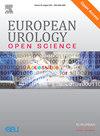Predicting Urinary Function Outcomes Following Low-dose-rate Brachytherapy for Prostate Cancer
IF 3.2
3区 医学
Q1 UROLOGY & NEPHROLOGY
引用次数: 0
Abstract
Background and objective
Our aim was to develop a tool using readily available clinical parameters to predict the probability of poor urinary function following low-dose-rate brachytherapy (LDR-BT) for localized prostate cancer.
Methods
Data from the multicentre, prospective Swiss LDR-BT cohort were analyzed for men treated with LDR-BT. Inclusion criteria were minimum follow-up of 3 yr or postoperative treatment with transurethral resection of the prostate (TURP). A total of 914 men were analyzed, with complete data available for 607 men. Pre-interventional variables assessed were International Prostate Symptom Score (IPSS), prostate volume (PV), maximum urinary flow rate, prostate-specific antigen, postvoid residual urine volume, and age. The primary outcome was poor urinary function after LDR-BT, defined as an IPSS-Quality of Life score >3 (“mostly dissatisfied” or worse) at 3 yr or the occurrence of TURP during follow-up. Associations were evaluated using univariable and multivariable logistic regression. Receiver operating characteristic curve analysis was also performed.
Key findings and limitations
Poor urinary function outcomes were observed in 46 patients (5.0%). Significant predictors included pre-interventional IPSS (adjusted odds ratio [aOR] per point 1.18; p < 0.001) and PV (aOR per ml, 1.04; p = 0.004). Limitations of the study include potential selection bias and the absence of external validation.
Conclusions and clinical implications
Pre-interventional IPSS and PV were significant predictors of poor urinary function after LDR-BT for prostate cancer. A risk calculator based on these parameters was developed to assist individualized treatment planning. Further studies are needed to validate these findings before they can be applied in routine clinical practice.
Patient summary
We created a tool to predict the likelihood of urinary problems after a type of radiotherapy called brachytherapy for prostate cancer. The size of the prostate and urinary symptoms before treatment were associated with poor urinary function after treatment. This tool could help doctors and patients in making informed decisions about treatment for prostate cancer.
低剂量率前列腺癌近距离放射治疗后泌尿功能预后的预测。
背景和目的:我们的目的是开发一种工具,使用现成的临床参数来预测局限性前列腺癌低剂量率近距离放射治疗(LDR-BT)后尿功能不良的可能性。方法:来自多中心、前瞻性瑞士LDR-BT队列的数据分析了接受LDR-BT治疗的男性。纳入标准为至少随访3年或术后经尿道前列腺切除术(TURP)。共分析了914名男性,其中607名男性有完整的数据。介入前评估的变量包括国际前列腺症状评分(IPSS)、前列腺体积(PV)、最大尿流率、前列腺特异性抗原、空隙后残留尿量和年龄。主要结局是LDR-BT后的泌尿功能差,定义为3年时ipss生活质量评分bbbb3(“大多数不满意”或更差)或随访期间发生TURP。使用单变量和多变量逻辑回归评估相关性。并进行了受试者工作特征曲线分析。主要发现和局限性:46例患者(5.0%)尿功能不良。显著预测因子包括介入前IPSS(校正优势比[aOR]每点1.18;p = 0.004)。该研究的局限性包括潜在的选择偏倚和缺乏外部验证。结论及临床意义:介入前IPSS和PV是前列腺癌LDR-BT术后尿功能不良的重要预测指标。基于这些参数开发了一个风险计算器,以协助个体化治疗计划。在将这些发现应用于常规临床实践之前,需要进一步的研究来验证这些发现。患者总结:我们创造了一种工具来预测前列腺癌近距离放疗后泌尿系统问题的可能性。治疗前前列腺大小和泌尿系统症状与治疗后泌尿功能不良相关。这个工具可以帮助医生和病人在前列腺癌治疗方面做出明智的决定。
本文章由计算机程序翻译,如有差异,请以英文原文为准。
求助全文
约1分钟内获得全文
求助全文
来源期刊

European Urology Open Science
UROLOGY & NEPHROLOGY-
CiteScore
3.40
自引率
4.00%
发文量
1183
审稿时长
49 days
 求助内容:
求助内容: 应助结果提醒方式:
应助结果提醒方式:


